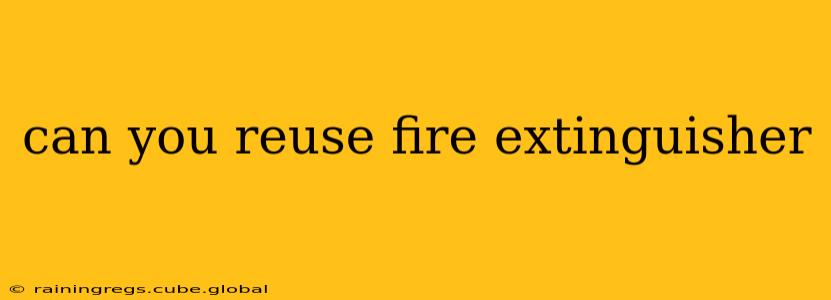Can You Reuse a Fire Extinguisher? The Definitive Guide
Fire extinguishers are lifesavers, but their usefulness doesn't end after a single use. The question, "Can you reuse a fire extinguisher?" is more nuanced than a simple yes or no. The answer depends heavily on several factors, and understanding these factors is crucial for safety and compliance.
H2: What Happens When a Fire Extinguisher is Used?
When you discharge a fire extinguisher, you deplete its pressurized extinguishing agent. This agent, whether it's water, foam, dry chemical, or CO2, is what actually puts out the fire. Simply refilling the cylinder with the appropriate agent isn't enough; the extinguisher also needs a thorough inspection and servicing. The internal components may have been damaged or compromised during use, rendering the extinguisher ineffective or even dangerous.
H2: Is it Safe to Reuse a Fire Extinguisher After Use?
No, it's not safe to simply reuse a fire extinguisher after discharging it. Here's why:
-
Internal Damage: The intense pressure and the force of the discharge can damage internal components like the hose, nozzle, or pressure gauge. These components are essential for the extinguisher's proper function. A damaged extinguisher might not discharge correctly, fail to release enough extinguishing agent, or even malfunction dangerously.
-
Contamination: The extinguishing agent itself may have become contaminated during use. Depending on the type of fire, residue or debris might clog the nozzle or contaminate the remaining agent. This contamination can compromise the extinguisher's effectiveness.
-
Pressure Loss: After discharge, the extinguisher will lose its pressure. While some extinguishers are designed for refilling, merely refilling a discharged extinguisher without inspection and servicing is risky and potentially unsafe. The pressure gauge might not accurately reflect the internal pressure after reuse, leading to unpredictable performance.
H2: How Should I Handle a Used Fire Extinguisher?
Once you've used a fire extinguisher, follow these steps:
-
Safety First: Ensure the fire is completely extinguished and the area is safe before approaching the used extinguisher.
-
Professional Inspection: Contact a certified fire extinguisher service technician. They will inspect the extinguisher thoroughly, checking for any damage or malfunction.
-
Recharging/Replacement: The technician will determine if the extinguisher can be recharged or if it needs to be replaced. Recharging involves refilling the cylinder and performing necessary maintenance. If the extinguisher is damaged beyond repair, the technician will recommend replacement.
-
Proper Disposal: If the extinguisher is deemed irreparable, the technician will guide you on proper disposal procedures. Never attempt to dispose of a fire extinguisher improperly, as it poses environmental and safety risks.
H2: What are the Costs Involved in Reusing a Fire Extinguisher?
The cost of reusing a fire extinguisher will vary based on several factors, including the type of extinguisher, the extent of damage, and the service provider's fees. Generally, it will be more economical to recharge a functional extinguisher than to buy a new one. However, if significant damage is found during inspection, replacement might be a more cost-effective and safer option in the long run.
H2: How Often Should Fire Extinguishers Be Serviced?
Regular servicing is crucial for maintaining the functionality and safety of your fire extinguishers. This typically involves a visual inspection and pressure testing at least annually, as required by many safety regulations and building codes. The frequency of servicing may vary depending on local regulations and the type of extinguisher. Always follow the manufacturer's recommendations and consult with a professional for guidance.
H2: Can I refill a fire extinguisher myself?
No, attempting to refill a fire extinguisher yourself is extremely dangerous and strongly discouraged. Recharging requires specialized equipment, knowledge, and training to ensure the extinguisher is properly refilled and pressurized safely. Improper refilling can result in serious injury or even death.
By following these guidelines and consulting with a qualified professional, you can ensure the safe and effective reuse of your fire extinguisher or responsible disposal if necessary. Remember, safety should always be your top priority.
